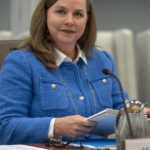Russia’s economy has been surprisingly resilient in the face of Western sanctions that were triggered by President Vladimir Putin’s invasion of Ukraine in 2022.
But as Putin gets set to meet President Donald Trump in Alaska on Friday to discuss ending the war, there are more signs of strain in the Russian economy and fiscal situation.
Meanwhile, government finances have been under growing pressure too. The Kremlin’s oil and gas revenue, which is its main source of funds, tumbled 27% in July from a year ago to 787.3 billion rubles, or about $9.8 billion.
That’s as crude oil prices have fallen, while Europe has continued to add sanctions on Moscow and crack down on the “shadow fleet” of tankers delivering Russian crude supplies.
Even as revenue weakens, spending keeps soaring amid Russia’s relentless attacks on Ukraine. In addition to outlays for weapons, incentives to mobilize more volunteers for the army as well as compensation to families of dead soldiers remain sky high.
The result has been widening deficits, with the gap for the first seven months of the year reaching $61.44 billion, or 2.2% of GDP, up from 1.7% during the first six months of the year.
Spending from January to July shot up 20.8% compared to the same period a year ago, while revenue increased just 2.8% during that span.
So Russia has had to tap reserves in its National Wealth Fund, which has dwindled from $135 billion in January 2022 to just $35 billion this past May, according to Åslund, who predicted that the fund is set to run out in the second half of this year.
“Russia’s economy is fast approaching a fiscal crunch that will encumber its war effort,” he added. “Though that may not be enough to compel Putin to seek peace, it does suggest that the walls are closing in on him.”
For now, Moscow has avoided steeper penalties from the U.S. as Trump backed off from this threat to impose secondary sanctions that would hit buyers of Russian oil, choosing instead to try reviving cease-fire talks in Alaska.
An earlier round of negotiations in April to stop the fighting included a proposal from Trump’s envoy to lift U.S. economic sanctions on Russia, require neutrality for Ukraine, and recognize territory Russia seized. Ukrainian and European officials rejected those terms, and talks failed to produce a deal.
On Friday, Trump predicted some land would have to change hands to reach an agreement this time.
“You’re looking at territory that’s been fought over for 3½ years with—you know, a lot of Russians have died, a lot of Ukrainians have died,” he said. “There’ll be some swapping of territories to the betterment of both.”









